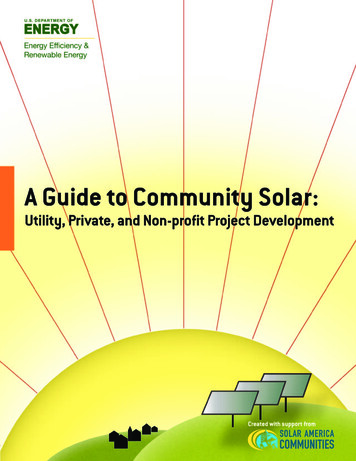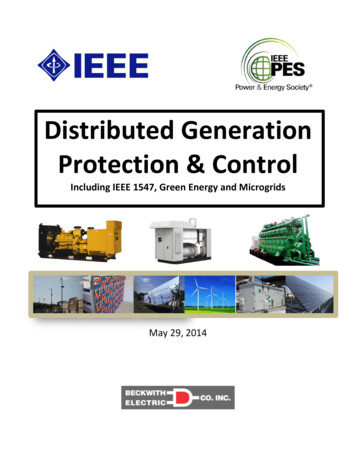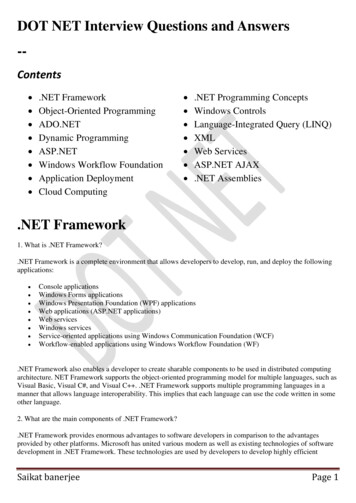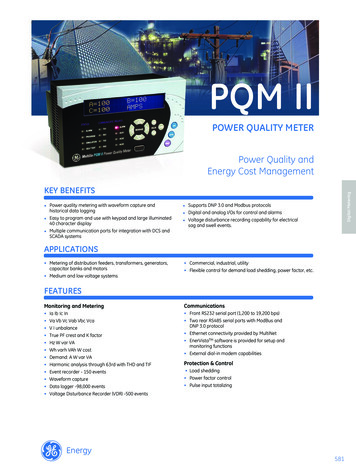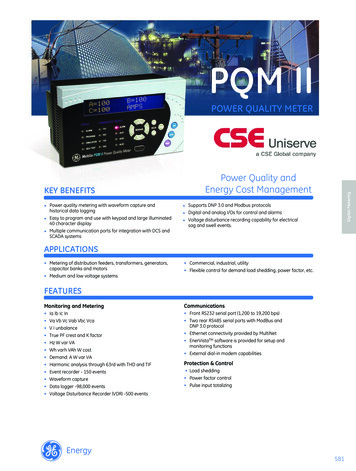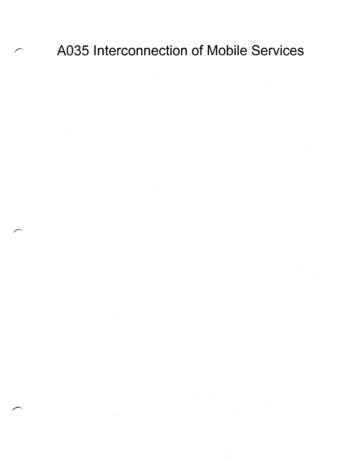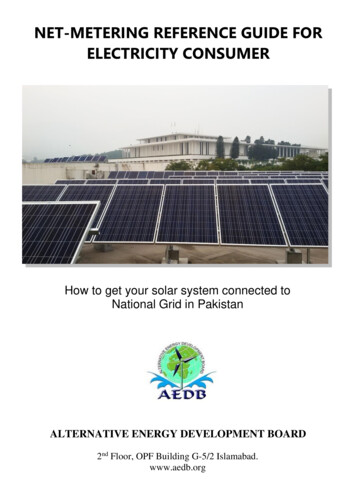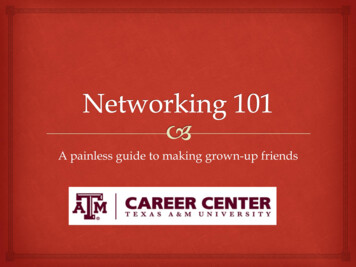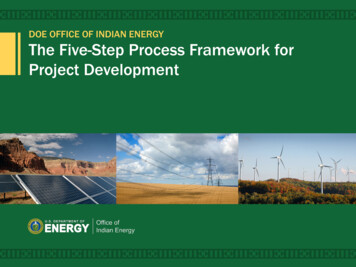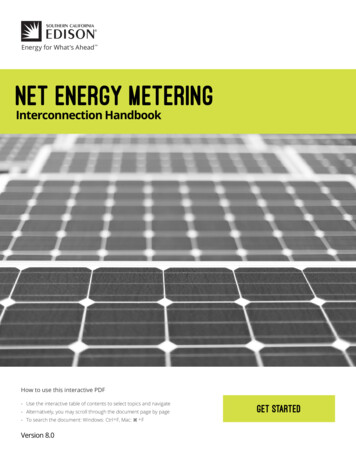
Transcription
Energy for What’s AheadSMNet EnergyEnergy InterconnectionHow to use this interactive PDF- Use the interactive table of contents to select topics and navigate- Alternatively, you may scroll through the document page by page- To search the document: Windows: Ctrl F, Mac: FVersion 8.0Get Started
What’s NewEffective Date: June 2020This handbook has been reorganized from the previous version and the following additional informationhas been added and/or modified: Section 3 – Clarifies when SCE must be present to witness the Commissioning Test Section 5 – Clarified requirements for line side taps Section 5 – Remote Control Switch-Generation requirements Section 6 – Modified energy storage system requirements based on new CPUC mandate Section 6 – Certified Control System Options for NEM-Large Paired Storage Section 6– Maximum Continuous Discharge Sizing Option for NEM-Paired Storage System Section 7.1 – Information on NGOM Installation Process Flow Appendix G – Net Generating Output Meter (NGOM) Panel EUSERC Drawing Number Guide Tablenext
Table Of Contents1Overview1.1 Eligible Customer-Generators with NEM special conditions are required to comply with NEM-ST. 72Reference Information2.1 Application Requirements.82.2 Equipment Information .82.3 Calculations.93Interconnection Review Process3.1 Document Review .113.2 SCE Witness of Commissioning Test .113.3 Interconnection Study.123.4 Review Fees .134Operating Evaluations4.1 Normal Voltage Operating Range .154.2 Limits Specific to Single-Phase Generating Facilities.154.3 Limits Specific to Three-Phase Generating Facilities.155General Requirements5.1 Inverter .165.2 Single Line Diagram .175.3 Line-Side Taps.185.4 Plot Plan Requirement .215.5 AC Disconnect Requirements .215.5.1 Visible Open AC Disconnect Switch Requirements Voltages 34.5KV or below .215.5.2 Frequently asked questions on AC Disconnects .225.5.3 AC Disconnect Type and Location Requirements .225.5.4 Self-Contained Meter4 with One Main Switch.235.5.5 Non-Self-Contained Meter – Secondary Voltage Connection .255.5.6 Primary Service Voltage Connections.265.5.7 Circumstances when AC Disconnect May be Opened by SCE .275.5.8 Remote Control Switch for Generation (RCS-G).28
6Paired Storage Requirements6.1 Sizing Requirements for NEM Interconnection with Paired Energy Storage .306.2 Options and Metering Requirements for NEM-Paired Storage Systems .306.3 Non-Export Relay for NEM-Large Paired Storage Systems.316.4 Net Generation Output Meter (NGOM) for NEM-Large Paired Storage Systems.326.5 Certified Control Systems for NEM-Large Paired Storage Systems.336.6 Maximum Continuous Discharge Sizing Option for NEM-Large Paired Storage Systems.337Net Generation Output Meter (NGOM)7.1 General Requirements for NGOM’s.357.2 Technical Requirements for NGOM’s.367.2.1 Single Line Diagram Requirements for NGOM’s.377.2.2 Plot Plan Requirements for NGOM’s.377.2.3 AC Disconnect Requirements for NGOM’s.377.2.4 Virtual NEM NGOM Installation.398Generation Meter Adapter (GMA)8.1 General Requirements for GMA’s .418.1.1 Documentation Requirements for GMA’s .418.1.2 Eligible Service Panels for GMA Installations .428.1.3 Ineligible Service Panels for GMA Installations.438.2 Technical Requirements for GMA’s.438.2.1 Single Line Diagram Requirements for GMA’s.438.2.2 Plot Plan Requirements for GMA’s .448.2.3 AC Disconnect Requirements for GMA’s.448.2.4 Grounding Customer Systems Downstream of GMA.459Protection Requirements9.1 Protection Requirements .469.2 Inverter Protection Settings.479.3 Ground-Fault-Sensing and Stabilization.479.4 Secondary Network Interconnection .479.5 Telemetering .4810 Miscellaneous Requirements10.1 Plug-In Generation Facilities to Electrical Wall Outlet.4910.2 Variance for AC Disconnects.49
11 Definitions11.1 Definitions.5011.2 Acronyms .51AppendixAppendix A: Sample Single Line Diagram .53Appendix B: Sample Single Line Diagram for GMA installations.54Appendix C: Sample Plot Plan.55Appendix D: Inverter Settings Request.56Appendix E: Maximum Borderline of Irritation Curve.57Appendix F: Supply Side / Line Side connections .58Appendix G: Net Generation Output Meter (NGOM) Panel EUSERC Drawing Number Guide Table.60
(1) Overview1 OverviewA generating facility may not be operated in parallel with SCE’s Distribution System UNTIL WRITTENPERMISSION TO OPERATE IS GRANTED BY SCE, as required in SCE’s Rule 21 (PDF). Unauthorizedoperation may be dangerous and may result in injury to persons and/or may cause damage toequipment and/or property for which the customer may be liable.This NEM Interconnection Handbook specifies the typical minimum technical requirements to interconnectgenerating facilities with SCE’s electric system under the Net Energy Metering (NEM) program. Theserequirements are necessary to ensure the safe and reliable operation of SCE’s electric system.These requirements apply to the interconnection of a generating facility to SCE’s electrical Distribution Systemthrough the NEM program under the following SCE rate schedules: Schedule NEM-ST (PDF): Net Energy Metering (including NEM Aggregation and Multiple Tariff) Schedule FC-NEM (PDF): Fuel Cell Net Energy Metering Schedule NEM-V-ST (PDF): Multi-Tenant, Multi-Meter Virtual Net Metering Schedule SOMAH-VNM-ST (PDF): Solar on Multi-Family Affordable Housing Virtual Net Metering Schedule MASH-VNM-ST (PDF): Multi-Family Affordable Solar Housing Virtual Net Metering(Note: SCE is no longer accepting MASH-VNM-ST applications due to program phase out) Schedule BG-NEM (PDF): Biogas Net Energy Metering(Note: Biogas digester generators must have commenced operation by December 31, 2009 to be eligible forthe BG-NEM tariff)This handbook does not address other types of generator interconnections under Rule 21 (PDF) or theWholesale Distribution Access Tariff (WDAT). Note: Schedule RES-BCT (PDF) (Renewable Energy SelfGeneration - Bill Credit Transfer) is addressed under Rule 21. For technical requirements for interconnectionunder Rule 21 (PDF) or WDAT, please refer to SCE’s Interconnection Handbook (PDF).Under the NEM program (CPUC §2827), customers installing generating facilities are eligible to interconnectif the generating facility is located on the customer’s premises, generates electricity from a renewable sourcepursuant to paragraph (1) of subdivision (a) of Section 25741 of the Public Resources Code (i.e., biomass,solar thermal, photovoltaic, wind, geothermal, fuel cells using renewable fuels, small hydroelectric generation,digester gas, municipal solid waste conversion, landfill gas, ocean wave, ocean thermal, or tidal current), fuelcells or biogas, or a hybrid of these technologies, and is sized to offset all or part of the customer’s electricalrequirements. NEM 2.0 generating facilities with a gross name plate rating larger than 1 MW, NEM Aggregationrequesting a new service, or NEM Aggregation retrofitting an existing service panel on a distribution circuitsNEM Interconnection Handbook: 2020 6
(1) Overviewmay require additional studies or be part of the Distribution Group Study at the customer's expense. ReferenceRule 21 section F.3.C. To deliver incidental power to the grid, a customer’s generating system must be locatedon the customer’s premises and be interconnected to SCE’s electrical system, i.e., permanently connected toallow “parallel operation” with the utility grid.1.1 Eligible Customer-Generators with NEM special conditions are required tocomply with NEM-ST(reference Schedule NEM-ST, Net Energy Metering Successor Tariff) California Department of Corrections (CDCR) generating facilities from 1 MW and not exceeding8 MW. U.S. Armed Forces limited to the lesser of 12 MW or 1 MW over minimum load over the preceding36 months.Note: An adjustment will be made by SCE, using existing telemetry data where available or informationprovided by the customer, to account for load served by existing on-site generation (so that thedetermination of minimum load is not reduced by on-site generation). SCE may make additionaladjustments, if necessary, to account for anomalies, such as outages, and may rely on mode minimumload registrations, daytime minimum load registrations, or other methods to reasonably determine thecustomer’s minimum load for the sole purpose outlined above. A customer’s minimum load determinationshall only be updated at the request of the customer or any time a new NEM Interconnection Request forthe United States Armed Forces base or facility is submitted.NOTE: The NEM tariff is applicable for renewable electrical generating facilities that are intendedprimarily to offset part or all of the customer’s own electrical usage and must be located on thecustomer’s Premise. For generating facilities utilizing fuel cell technology that qualifies as renewable,the total Renewable Electrical Generating Facility’s capacity must not exceed 5 MW CEC-AC Nameplaterating and the lesser of 5 MW aggregate inverter capacity or 5 MW aggregate Fuel Cell gross nameplatecapacity and must be located on the customer’s Premise.NEM Interconnection Handbook: 2020 7
(2) Reference Information(2) Reference Information2.1 Application RequirementsAt www.sce.com/nem, SCE provides information about the NEM Program, NEM-ST Rate Schedules andrequired forms. Additionally, there is an Application Checklist, a sample Single Line Diagram and Plot Planavailable for download.NEM applicants are now required to use SCE’s NEM online interconnection SCE’s NEM Online InterconnectionApplication System to submit an Interconnection Request (IR). Please access the online application system toview the status of an IR or submit additional documentation.2.2 Equipment InformationTable 2.2-1: Equipment ListingsEquipmentGrid Support InvertersSolar PV ModulesEquipment ListingsFull List: https://www.energy.ca.gov/media/2365Simplified List: https://www.energy.ca.gov/media/2366Full List: https://www.energy.ca.gov/media/2367Simplified List: https://www.energy.ca.gov/media/2368Wind Turbines & Fuel CellsRenewables Portfolio Standard Eligibility Commission GuidebookBattery & Energy Storage SystemsGo Solar - Battery and Energy Storage SystemsNOTE: The certification listings above identify some of the electrical components of a generatingfacility. These components must be incorporated in the generating electrical design and shown on theSingle Line Diagram (SLD) to ensure that the generating facility as a whole is compliant with the NEMtariff requirements.If the proposed equipment is not listed on the certified equipment list, UL Certification of the equipment willneed to be submitted to the CEC to be verified and added to the online listing. See Section 5 for details.NEM Interconnection Handbook: 2020 8
(2) Reference Information2.3 CalculationsFor the purposes of the NEM Interconnection Application, the following formulas are used to calculate CEC-ACnameplate system size (kW) and estimated monthly kWh output:Table 2.2-2: CEC-AC Nameplate Calculation for Inverter based Generation FacilitiesTechnologyCEC-AC Nameplate CalculationSolar PV(Qty of PV Modules) x (PTC Rating) x (Inverter Efficiency %) / 1000 kWWind(Qty of Turbines) x (Power Output) x (Inverter Efficiency %) / 1000 kWFuel Cell(Qty of Cells) x (Rated Output) x (Inverter Efficiency %) / 1000 kWTable 2.2-4: Estimated Annual kWh CalculationTechnologySolar PVEstimated Annual kWhUse the CSI EPBB calculator at www.csi-epbb.com or:(CEC-AC Nameplate) x 720 x 0.20 x 12 kWhWind(CEC-AC Nameplate) x 720 x 0.15 x 12 kWhFuel Cell(CEC-AC Nameplate) x 720 x 0.85 x 12 kWhNOTE: Both the CEC-AC rating and the aggregate inverter capacity must be than 1 MW for a generatingfacility to be considered 1 MW or smaller.NEM Interconnection Handbook: 2020 9
(3) Interconnection Review Process(3) Interconnection Review ProcessAfter an initial review to confirm the Application and SLD are complete and consistent with interconnectionrequirements, the NEM Interconnection team may refer the project for technical review and approval. Uponreferral, the installer is provided notice and contact information for the engineer assigned to the project. AtSCE’s discretion, an onsite inspection and commissioning test may be required as part of the technical review– see Section 3.2 for more detailed information.The design must be in accordance with: SCE’s Electric Rule 21 (PDF) SCE’s Electric Service Requirements (ESR) (PDF) SCE’s Interconnection Handbook (PDF) NFPA’s National Electric Code, and All applicable local codes and ordinancesThe purpose of the technical review is to facilitate the safe interconnection of eligible NEM generators tothe SCE electrical Distribution System. To ensure the generator interconnection is in compliance with SCEinterconnection requirements, the customer’s generating facility will, at a minimum, be reviewed to ensurethat the generating facility will: Not unintentionally operate in an islanded mode with SCE’s electrical system as required byIEEE 1547, UL 1741, and UL1741-SA When required, have a visible open, lockable disconnect switch and/or rackable breaker for isolationpurposes, comply with Rule 21 and SCE’s Electric Service Requirements (ESR) When required, have the required relay or control equipment and set as required to meet NEMrequirementsIf the generating facility exceeds the operating capabilities of the Distribution System relative to voltagecontrol, system overload, system operating flexibility or other system condition, it will be required to mitigatesuch condition prior to SCE providing technical approval. An NEM customer must bear the cost of theInterconnection Facilities and distribution upgrades as may be applicable. Please refer to Decision 02-03-057,Rule 21, Section E.4., and Public Utilities Code Section 2827(g) for the delineation of cost responsibilitiesfor Distribution Upgrades versus Interconnection Facilities. Failure to comply with all the requirementsin this section may result in potential delays. If the review determines corrections are needed, they must becompleted prior to the Permission to Operate (PTO) being issued and the customer is responsible for all costs.NEM Interconnection Handbook: 2020 10
(3) Interconnection Review Process3.1 Document ReviewThe following documents are required before SCE will begin the technical review of a proposed generatingfacility: Completed online application Form: See NEM Interconnection Checklists at sce.com/nem Single Line Diagram: see Section 5 for detailed requirements and Appendix A for a sample Photos of the AC Disconnect Switch (and overcurrent protection): See Section 5 for requirements.The following additional information may also be required based on the size/configuration of the proposedsystem: Smart Inverter Specifications and smart inverter settings: See Section 5 for more information;Plot Plan: See Section 5 for circumstances when a Plot Plan is required and Appendix C for asample.Note: A Plot Plan is required whenever an AC disconnect is required. Net Generation Output Meter (NGOM) installations: See Section 7 for additional documentationrequired. Generation Meter Adapter (GMA) installations: See Section 8. for additional documentationrequired. Line Side / Supply Side Taps: See Section 5 & Appendix F. If transformers are used to interconnect the Generating Facility with SCE’s Distribution System,please provide the transformer nameplate information (e.g., voltages, capacity, windingarrangements, connections, impedance). If a transfer switch or scheme is used to interconnect the Generating Facility with SCE’s DistributionSystem, please provide component descriptions, capacity ratings, and a technical description ofhow the transfer scheme is intended to operate. If protective relays are used to control the interconnection, please provide protection diagramsor elementary drawings showing relay wiring and connections, proposed relay settings, anda description of how the protection scheme is intended to function: See Section 6 for moreinformation.3.2 SCE Witness of Commissioning TestSCE intends to conduct a witness test and onsite inspection for a specific set of projects that meet criteriaoutline below. When a witness test is required, a representative of the installer qualified to operate theequipment must be present.Before a witness test will be scheduled, SCE requires a copy of the Electrical Inspection Release from theappropriate Authority Having Jurisdiction (e.g., final inspection job card from the local building and safetydepartment) to ensure that the work on the customer’s side of the meter has been permitted, meets theNEM Interconnection Handbook: 2020 11
(3) Interconnection Review Processrequirements of the National Electric Code, applicable local codes and ordinances, and is therefore safe toenergize.The onsite inspection will ensure that the installation reflects what is shown on the single line diagram and thedocuments provided by the applicant for the generating facility. Requirements such as Rule 21, Section H orSection Hh, voltage and frequency will be tested and verified during the commissioning test.SCE requires an SCE engineer to be present and witness the commissioning test of projects that fit thedescription of any of the criteria below: Projects that utilize relay(s) or control system(s) Projects that require or rely on the use of Distribution Equipment Projects whereby harmonic evaluation needs to occur Projects where customer has not provided sufficient information for SCE to verify the compliancerequirementsSCE may waive the witness of commissioning requirements if there is means to verify the requirementsthrough the submittal of documentation (E.g. Specifications, Photos).NOTE: SCE reserves the right to request to witness the commissioning test of any project. Regardlessof the results of the commissioning test, the customer is not authorized to energize the system untilSCE issues a Permission to Operate (PTO) letter. Once the assigned Engineer returns the project to theNEM IC group, PTO will typically be issued within five business days.3.3 Interconnection StudyIf, during the initial and supplemental reviews, it is determined that an interconnection study is required,SCE will perform the study in accordance with Rule 21 timelines. The interconnection study will detail anyadditional Interconnection Facilities or Distribution Upgrades that will be needed to accommodate theapplicant’s generating facility. If the generating facility exceeds the operating capabilities of the DistributionSystem relative to voltage control, system overload, system operating flexibility or other system condition, itwill be required to mitigate such conditions prior to SCE providing technical approval. In addition, SCE mayrequire that the customer perform a harmonic study during the execution and construction phase to ensurethat the generation facility complies with the harmonic current limits outlined in IEEE 519-2014. For projectover 1 MW and NEM Aggregation projects, the customer is responsible paying all upgrades and related studies.NEM Interconnection Handbook: 2020 12
(3) Interconnection Review Process3.4 Review FeesApplication fees for NEM Successor Tariff vary depending on the generating capacity of the system. Theapplication fees are as follows: 1 megawatt (MW) or smaller - 75 Above 1MW - 800NOTE: Both the CEC-AC rating and the aggregate inverter capacity must be than 1 MW for a generating¡facilityto be considered 1 MW or smaller.NEM Interconnection Handbook: 2020 13
(4) Operating Evaluations(4) Operating EvaluationsThe generator operator/customer may operate the generating facility during grid power interruption only whenthe customer facility has been electrically isolated from the grid via opening the customer’s main breaker orother applicable device. All required settings (such as anti-islanding, volt/var, and volt/watt) must be activatedprior to reconnection to the distribution grid. SCE may specify additional commissioning test requirements forgenerating facilities with capabilities to operate islanded in microgrid.Islanding1 with SCE systems will not be permitted under any circumstance.Technical Approval is based on the Rule 21 Fast Track initial review screens that include criteria’s below: Generating Facility capacity on the line section is less than 15%: the applicant’s generatingfacility combined with existing generation does not exceed 15% of the maximum loading of the linesection. For more information, please refer to Rule 21, Section G.1.m. Overloading: all distribution equipment must not be overloaded by the applicant’s generatingfacility. Voltage Operating Levels: the applicant’s generating facility must not create a voltage drop or risethat is outside the allowable operating-voltage bandwidth specified in Rule 21 and Rule 2 (PDF). System Upgrades: upon review by SCE, system u
SCE’s Interconnection Handbook (PDF). . generates electricity from a renewable source pursuant to paragraph (1) of subdivision (a) of Section 25741 of the Public Resources Code (i.e., biomass, solar thermal, photovoltaic, wind, geothermal, fuelcel
